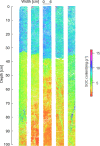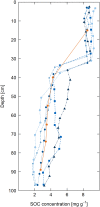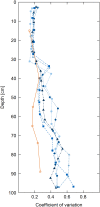Hotspots of soil organic carbon storage revealed by laboratory hyperspectral imaging
- PMID: 30224656
- PMCID: PMC6141473
- DOI: 10.1038/s41598-018-31776-w
Hotspots of soil organic carbon storage revealed by laboratory hyperspectral imaging
Abstract
Subsoil organic carbon (OC) is generally lower in content and more heterogeneous than topsoil OC, rendering it difficult to detect significant differences in subsoil OC storage. We tested the application of laboratory hyperspectral imaging with a variety of machine learning approaches to predict OC distribution in undisturbed soil cores. Using a bias-corrected random forest we were able to reproduce the OC distribution in the soil cores with very good to excellent model goodness-of-fit, enabling us to map the spatial distribution of OC in the soil cores at very high resolution (~53 × 53 µm). Despite a large increase in variance and reduction in OC content with increasing depth, the high resolution of the images enabled statistically powerful analysis in spatial distribution of OC in the soil cores. In contrast to the relatively homogeneous distribution of OC in the plough horizon, the subsoil was characterized by distinct regions of OC enrichment and depletion, including biopores which contained ~2-10 times higher SOC contents than the soil matrix in close proximity. Laboratory hyperspectral imaging enables powerful, fine-scale investigations of the vertical distribution of soil OC as well as hotspots of OC storage in undisturbed samples, overcoming limitations of traditional soil sampling campaigns.
Conflict of interest statement
The authors declare no competing interests.
Figures







References
-
- Batjes NH. Total carbon and nitrogen in the soils of the world. European Journal of Soil Science. 1996;47:151–163. doi: 10.1111/j.1365-2389.1996.tb01386.x. - DOI
-
- Hobley E, Wilson B, Wilkie A, Gray J, Koen T. Drivers of soil organic carbon storage and vertical distribution in Eastern Australia. Plant Soil. 2015;390:111–127. doi: 10.1007/s11104-015-2380-1. - DOI
Publication types
Grants and funding
LinkOut - more resources
Full Text Sources
Other Literature Sources

